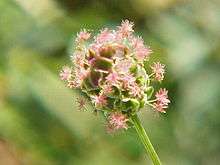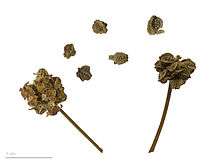Sanguisorba minor
| Sanguisorba minor | |
|---|---|
 | |
| Scientific classification | |
| Kingdom: | Plantae |
| (unranked): | Angiosperms |
| (unranked): | Eudicots |
| (unranked): | Rosids |
| Order: | Rosales |
| Family: | Rosaceae |
| Genus: | Sanguisorba |
| Species: | S. minor |
| Binomial name | |
| Sanguisorba minor Scop. | |
| Synonyms | |
|
Poterium sanguisorba | |

Sanguisorba minor, the salad burnet, garden burnet, small burnet, burnet, is a plant in the family Rosaceae that is native to western, central and southern Europe; northwest Africa and southwest Western Asia; and which has naturalized in most of North America.[1][2] It is a perennial herbaceous plant growing to 40–90 cm tall, typically found in dry grassy meadows, often on limestone soils. It is drought-tolerant, and grows all year around.
It is used as an ingredient in both salads and dressings, having a flavor described as "light cucumber" and is considered interchangeable with mint leaves in some recipes, depending on the intended effect. Typically, the youngest leaves are used, as they tend to become bitter as they age.
Salad burnet has the same medicinal qualities as medicinal burnet (Sanguisorba officinalis). It was used as a tea to relieve diarrhea in the past.
It also has a respectable history, called a favorite herb by Francis Bacon, and was brought to the New World with the first English colonists, even getting special mention by Thomas Jefferson.
References
- ↑ "Link to ITIS entry". Retrieved May 1, 2012.
- ↑ "Link to EOL entry". Retrieved May 1, 2012.
External links
- USDA Plants Profile
- Sanguisorba minor in the CalPhotos Photo Database, University of California, Berkeley
| Wikimedia Commons has media related to Salad Burnet (Sanguisorba minor). |